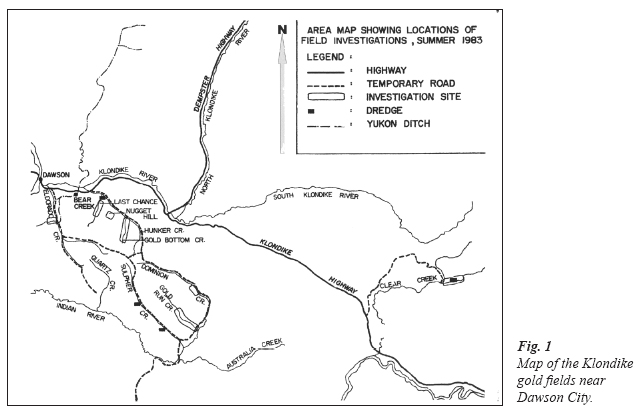Secondary Reuse of Materials in the Klondike Goldfields near Dawson City, Yukon
Michael GatesParks Canada
1 In 1983, under the auspices of a grant from the Canada Council for the Arts, the author undertook to travel into the gold mining regions surrounding Dawson City, the “Klondike capital” of the Yukon. The remains of old placer mining activities were located and recorded, some dating to before the Klondike gold rush, and interviews were conducted with long-time residents regarding the history of the region.1 The findings of this work were augmented by a literature survey that was undertaken after the initial fieldwork was completed.
2 This paper, based upon the examination of artifacts during this work and investigations conducted in subsequent years, focuses on an assemblage of in-situ artifacts from the goldfields surrounding Dawson City. It covers an area of approximately 3,500 square kilometres primarily south and east of Dawson City, Yukon, south of the Klondike River, east of the Yukon River and north of the Stewart River. The territory includes adjacent areas near Dawson City, primarily to the west in the Fortymile and Sixtymile regions (Fig. 1).
3 Secondary reuse refers to any object which was manufactured for a specific use and subsequently physically modified so that it may be used for a different purpose. This is distinct from artifact reuse or recycling, where the object has been put to a new use, for which it was not originally intended, but whose function may be difficult to detect because there is no change in form. This latter category creates problems because the study of the artifact alone will not reveal the reuse activity. Patterns of reuse have been described by others in an urban context in which information is derived from informant inquiry, rather than the analysis of physical evidence (Schiffer et al. 1981; Nicolaisen 1979). Comparisons with material examined in other regions of the Yukon and Alaska demonstrate that the phenomenon of secondary reuse, as described in this paper is not restricted to the study area, but is widespread.
Fig. 1 Map of the Klondike gold fields near Dawson City.The Materials
4 Great caches of tin cans could be found behind every cabin….There were hundreds of cabins, thus hundreds of thousands of tin cans—bully-beef, creamed corn, butter, devilled ham, lard, tomatoes, beans, beans, beans, preserved fruit, soup. Without the invention of the canning process, the Yukon could never have been settled (Berton 1973: 15).
5 During the field work, abandoned mining camps containing various sorts of machinery, industrial features and abandoned cabins were found to be common. Invariably associated with these sites were large refuse dumps, consisting of cast-off tin cans, bottles and various other materials (Fig. 2). During the period 1898 until roughly 1950, the study area was an isolated region with no road links to the outside world and where automobiles were uncommon. Residents still commonly identify the study region as an isolate, referring to areas beyond the Yukon as “outside.” Importation of food and other supplies was slow and expensive. A wide variety of products was imported in tin cans due to their durability and convenience. The most popular choice for modification and reuse was five-gallon liquid fuel cans (Fig. 3). These containers were large enough in size to be used for a wide variety of applications. Wooden packing boxes, though not as common as a source material, were popular choices for a small number of applications. Glass, primarily in the form of beverage containers, was widely distributed, though not as adaptable to modification. A number of other materials have been reused, but with less frequency and in more restricted or unique applications.
Fig. 2 A typical refuse dump from Dominion Creek. Photo number SL 277-02, by M. Gates.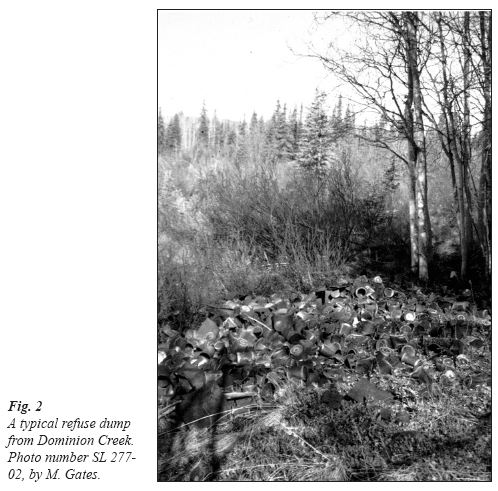
Display large image of Figure 2
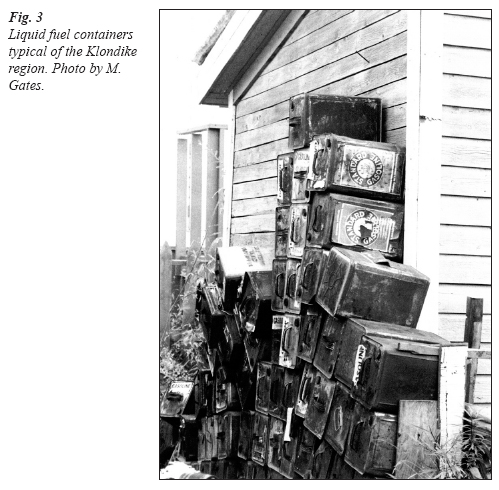
Display large image of Figure 3
6 The five-gallon (U.S.) liquid fuel container was the most common and versatile source material for secondary reuse. Until the second half of the century, these cans were a primary way to transport fuels to the Klondike. They are ubiquitous in old mining and occupation sites throughout the Dawson City area. These cans measure 36 centimetres high by 23 centimetres square, with a small cap or pouring spout, and a carrying handle on top. The type of cap and handle varies by factors such as manufacturer and date of fabrication; the variability of design was not investigated as part of this study. These containers were frequently imported to the Yukon in pairs in closed wooden crates, (Hunter 1984: 64) which have themselves been observed in different reuse applications. Also common are lard containers of the one gallon size or larger. Tobacco and coffee tins are common sources of reuse, while other smaller tin containers are found in a variety of applications.
Modifications
7 Each of the source materials for secondary reuse artifacts is subject to a variety of working and modification techniques. Tin cans are by far the most popular choice in this regard because of the reworking methods that can be applied to them. The source material for tin cans is malleable and can be bent or shaped easily. It can be cut, bent, riveted, nailed and screwed through, soldered, cut, drilled, punched folded, rolled and scribed with ease, as will be seen in the variety of reuse applications which are described below.
8 Wood has different physical properties which qualify it for a different suite of applications. It is rigid, with considerable strength, when compared with tin. It cannot be bent or flexed in the ways that tin can be, but is of considerable value where more structural strength is required. Wood can be sawn, nailed or screwed, drilled and glued. Wood is not as durable under the depositional conditions where goldfield reuse artifacts are found. Under damp conditions, and in close contact with the ground, it decomposes and disappears more rapidly than its tin counterpart.
9 Glass is far more common than wood at old occupation and activity sites in the study area, but it is the least adaptable material described here, which may explain the limited number of reuse applications. Bottle collecting was observed during the field work; it is not known to what extent this activity has affected the representation of glass reuse artifacts in this study. Glass is transparent; it is also hard and rigid, with considerable structural strength, but is prone to shattering or breakage. It was seldom seen in reuse applications where there was modification, so is only included in the study sample where the reuse function was visible or evident. No examples of reuse of glass were provided by informants consulted during the study. Under the right conditions, glass can be modified by cutting. Modification using heat was not observed, perhaps because of the skill required to work it in a molten state, and because of the likelihood of failure if not re-worked this way in skilled hands.
Functions
10 The various functions to which these materials were applied have been determined primarily by examining surviving artifacts, augmented by historical documents such as photographs, books and oral histories.
Tin cans
11 The most common function was as a receptacle or container (Berton 1972: 57). Five-gallon fuel tins were frequently modified into a pail or bucket to carry water or other substances (Figs. 4, 5). For this purpose, one end—usually the top—is removed or opened, and a handle added. Handles are usually made of some variety of wire, while wooden handles are not uncommon. Shoulder yokes have been fashioned from wood, with wire suspended from each end, from which to support a single can. Examples of containers with wooden handles observed in the field included a few where the handles were notched in the centre, presumably as the suspension point for carrying in this fashion.
Fig. 4 (Above) Reused fuel can, August, 1900. Note the wooden handle for carrying. Yukon Archives photo 3930.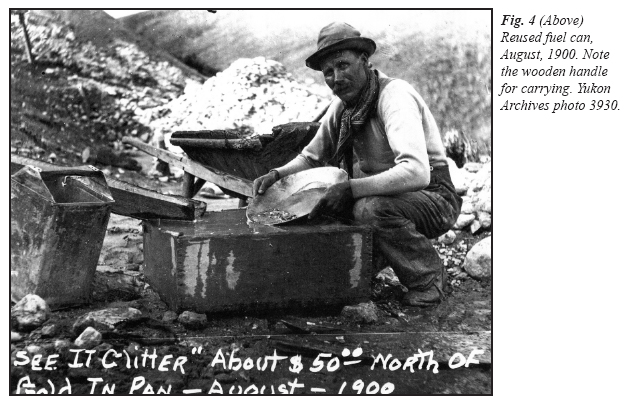
Display large image of Figure 4
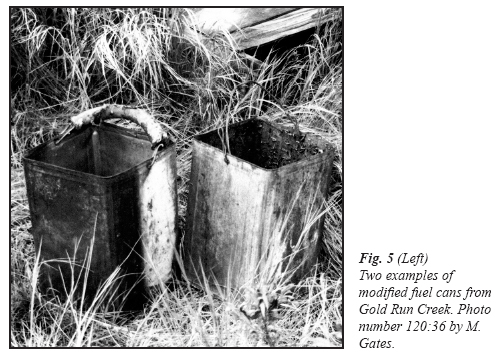
Display large image of Figure 5
12 Another common variation of the modified tin container is the dipper. As evident in numerous historical photographs of the gold rush era as well as examples observed in the field, smaller tin cans were adapted for use as dippers in a hand method of placer gold processing known as “rocking.” In this technique, the can is attached to a wooden handle of variable length, but usually less than 50 centimetres in length for scooping up small volumes of water that are poured over loose placer gravel in a small rocker box to aid in the capture of the gold (Fig. 6). In two cases, tin cans were attached to handles longer than 150 centimetres, for unknown uses which are not believed to have been gold rocking. Stanley (1898: 131) and Martinsen (1969: 266) report tin cans being used as containers for holding gold nuggets and I personally observed them being used as drip pans—such as those suspended beneath frequently lubricated motors, for dog food and for storing nuts and bolts. Specht (1976: 149) reports their usage as “honey buckets” for the storing and handling of human waste.
Fig. 6 Miners rocking for gold on Klondike hillside ca. 1900. Note the dippers being used to pour water. Yukon Archives 3928.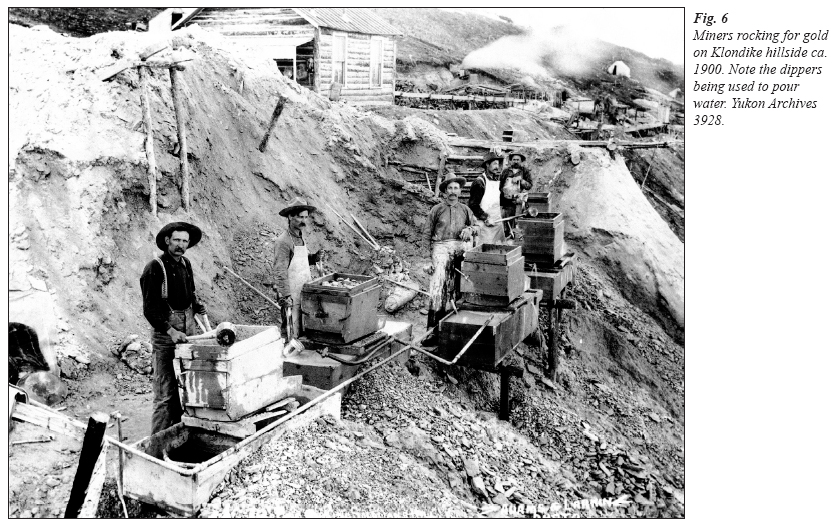
Display large image of Figure 6
13 The lighting device is the second most common application observed for the modification of tin cans. As one early miner observed:We lit the mine with candles. When Scavdale and Anderson were wheeling the dirt out to the dump, I always carried a candle lantern which I made out of an eight inch tin with one side cut out. (Procter 1975: 48)
14 The simplest design recorded was a tobacco tin with a hole punched in its lid, into which a candle was inserted. In a more common design, a hole is created in the bottom of a small tin by making two diagonally intersecting cuts and folding the triangular corners back so that a candle can be inserted up through it. Normally, one side or end is removed to allow the light out, and a wire handle is attached so the device can be carried safely (Fig. 7). The shiny interior surface of a newly modified container reflects a good light, and the enclosure into which the candle is inserted protects it from the wind. During the course of interviews with long-time residents of the goldfields, these devices were frequently referred to as “bugs.” When this term was introduced in a question to informants, they immediately recognized its usage and responded to it appropriately. This was the only documented instance when a special term was used to describe a category of reuse artifact.
15 In addition to the applications described above, more than two dozen other domestic uses have been recorded, including: tips on homemade skis, a crib-bage board and mouse trap (See Table). While some were used for decorative or recreational purposes, most were designed for practical applications.
Fig. 7 Tin can candle lamp or “bug” from Bonanza Creek. Photo 138-13 by M. Gates.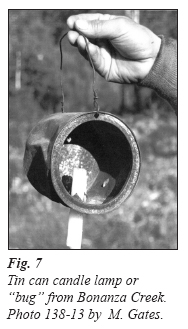
Display large image of Figure 7
16 Tin cans, especially the five-gallon fuel containers, were used in a variety of applications on buildings. For these uses, they were opened up and flattened out. In this flattened state, they were used to cover exterior walls and roofs (Fig. 8). Placed behind a wood stove or heater, they protected the wall from catching fire. They were used to patch holes and to encircle the legs of above-ground caches to make them rodent proof. Larger fuel containers have been observed with circular holes at both square ends to serve as a “safety,” through which a hot stovepipe could safely pass through a roof without causing a fire. In this application, it might be added, circular wash tubs were more commonly used as the source reuse material. In a few instances, tins of the right size have been observed shoved together to form lengths of stove pipe.
Wooden Boxes and Packing Containers
17 Though not as common as tin containers in reuse applications, wooden packing boxes served many a Klondike miner as furniture in his cabin. The source material was generally used to transport goods to the creeks and was frequently observed bearing a manufacturer’s or shipper’s identification. They have been used as mailboxes and small food caches (Berton 1972: 57, 167). Procter (1975: 44) noted their use as chairs, Marge Bergstrand,2 as cupboards (Fig. 9) and Greg Hoggan,3 reported the use of wooden boxes as bedside stands. It was also common in the goldfields to see birdhouses constructed from wooden boxes (Fig. 10).
Other Materials
18 The list of other materials reused is short. Early in the gold rush, bottles were frequently used in place of window glass in cabins (Adney 1994). On Gold Run Creek, a funnel was fashioned from a small graniteware bowl, a piece of wood and a short length of pipe (Fig. 11) and on Dominion Creek, an informant demonstrated a frying pan modified to function as a “grizzly,” a device which, by means of a series of parallel slits in the bottom of the pan, separated course granular material from fine, while panning gold during a clean-up. The most ambitious example of reuse that I have seen was the assembly, by the Boutellier brothers on Adams Gulch, of scrap metal and machinery, to which an engine was mounted, creating a caterpillar tractor.
Historical Context
19 Adaptive reuse by placer miners started very early in the history of mining in the Yukon. During the period before the Klondike gold rush, between 1873 and 1896, the Yukon River basin was a geographical isolate for Europeans. Transportation links with the outside world were infrequent, expensive and not always reliable. The earliest prospectors who entered the region came in with the barest of material essentials, and were thus forced to make-do in most circumstances (Gates 1994: 47-49).
20 The Klondike gold rush refers to an influx of tens of thousands of prospectors and miners, all of whom brought with them a ton or more of supplies as required by authorities. Many left within a short span of time, abandoning much of their supplies, leaving the Yukon still very much an isolate from the outside world. In later years, commercial goods were transported by ship from major supply centres in the south to the port of Skagway, where they were transferred to the White Pass and Yukon Route railway and carried to Whitehorse, where they were again transferred, this time to a fleet of sternwheel riverboats for transport downriver to Dawson City, the entrepôt to the goldfields.
Fig 8 Example of fuel cans reused to shingle a roof in Dawson City. Photo by M. Gates.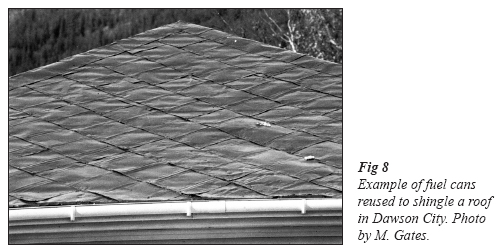
Display large image of Figure 8
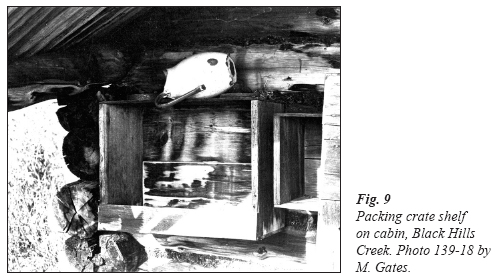
Display large image of Figure 9
21 At Dawson City, goods were transferred to horse and wagon or, occasionally in the winter, to dog sled for conveyance to the miners in the goldfields, some of whom lived a considerable distance from Dawson, often at the end of poorly maintained roads. Canned foods were an important dietary component, and it is not surprising to find so many cast aside behind each living site in the goldfields. Fuel was shipped in high volumes in tin containers. Wooden shipping containers were far more durable than cardboard for the long distance journey goods had to make from the outside.
22 In the early days, most miners travelled on foot. In the winter, connections to outside supplies were even more tenuous. The Klondike was virtually cut off from outside suppliers. Consequently, people ordered their supplies well in advance, and they were shipped in quantity during the short summer. The automobile was a rare occurrence until at least the early 1950s.
Fig. 10 Packing crate birdhouse, Miller Creek. Photo 132-21 by M. Gates.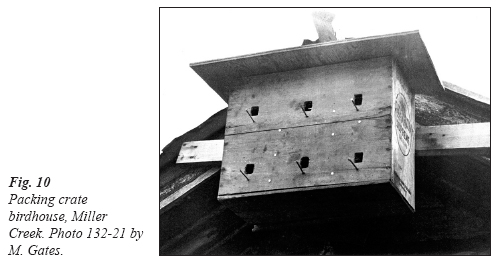
Display large image of Figure 10

Display large image of Figure 11
23 Many residents of the goldfields surrounding Dawson made infrequent trips to town; sometimes years would pass between visits. In at least one case, a gold field resident had not made the fifty-mile trip to Dawson City from Dominion Creek in 40 years (Berton 1987: 131-234). Under such circumstances, these people were not obtaining their material needs during frequent shopping trips. The opportunities for purchasing what was needed were few; the opportunities and need for on-site fabrication were constant.
Analysis
24 Nicolaisen (1979) made note of patterns of reuse from his own observations in the Hebridean islands, and New York State. He assigns reuse to three different categories:
- purely practical reuse for economic reasons
- modification for practical, but also decorative reasons
- modification for predominantly decorative or aesthetic reasons, but also with practical applications.
In the examples noted in the Klondike goldfields, the applications are predominantly practical, with little thought given to aesthetic considerations. While this classification enumerates the intended application or end use of the secondary reuse item, it omits other important variables, such as the workability of the source material, the circumstances under which they become available and the catalyst that drives the creative process. To adapt the phraseology of the modern-day television crime programs: motive, means and opportunity.
Motive
25 In the Yukon context, the motive is primarily one of expediency, driven by isolation. For the first half of the 20th century, transportation in the goldfields was limited, the automobile was not a common device and, when used, it usually had a commercial rather than personal application. The predominantly male population walked to town if they wanted to, or they could ride with a commercial carrier. Living in isolated conditions in the goldfields meant that when the object of one’s desire (or need) could not be immediately or easily acquired, the needs were met by improvisation.
Means
26 As already described above, the three main materials lent themselves to adaptation because of their physical properties and the simplicity with which they could be modified in a wide variety of ways. Though available in tremendous abundance, today’s plastic containers do not appear to have the universal workability of the conventional tin can; this may be one of the reasons they seem to appear more often in aesthetic applications, and less often in practical applications.
Opportunity
27 In the Klondike, the secondary reuse of tin cans, wooden packing boxes and other materials was facilitated by the abundance and availability of those materials. One need only walk to the ubiquitous dump of tin cans at any mining camp to find the raw materials. The circumstances that made these available in such abundance were the packaging methods of the period combined with isolation. Recycling, as we know it in the contemporary urban setting, did not exist or make sense in the Klondike goldfield: the cost of removal to a centralized dumping site was too high and the social and environmental incentives that we have today were not yet considered. Nevertheless, necessity and the availability of the raw goods resulted in, what may be described as, an early form of recycling.
Conclusion
28 The approach to analyzing secondary reuse materials adopted in this essay (motive, means and opportunity) seems to work in other examples from around the world, although the three vectors are different in character. Three examples will illustrate how this simple model might apply in other contexts. Take the example offered by Nicolaisen of metal dairy milk cans in eastern United States. After their obsolescence for use in the dairy business, these objects assumed a new function as supports for roadside mailboxes in rural areas. In this example, the opportunity arises from their abundance and obsolescence; the means arises from the ease with which these objects can be adapted to this new use. The motive is not merely the utilitarian function, but also, according to the author, the re-creation of a phantom past, the symbolic or psychological attempt to recapture a kinder, simpler time (Nicolaisen 1979: 227-30).
29 Another case in point might be the glass house in Creston, British Columbia. This structure, completed in 1952, was constructed by a retired undertaker using thousands of formaldehyde bottles, to “to indulge a whim of a peculiar nature.” The building attracted attention from the outset, and was quickly converted from a whimsical construction into a tourist attraction. Here, the opportunity was the access the builder had to this peculiar source material. The means was the incorporation of thousands of bottles into the structure of a fanciful two storey home. While the bottles themselves were not modified, the use to which they were applied was completely different from the original intent, and the form to which they were applied was visibly distinctive. The motive in this case was certainly unusual, a combination of whimsy and practicality that quickly converted into an economic generator.
30 A third and unusual example of secondary reuse comes from Alcatraz where inmates of the infamous prison adapted a number of materials including raincoats (inflatable raft), a concertina (bellows for inflating the raft) and other things to create a periscope (to watch for guards), manikins (to create the appearance of sleeping prisoners) and an electrical drill (barber’s clippers and a vacuum cleaner motor) (Hall 1985: 113). Here the motive was obviously escape from prison. The opportunity was ingeniously derived from items to which the inmates had access, and means came from their ingenuity in assembling the disparate materials into an elaborate escape plan. Similar examples of secondary reuse can be found in the prisoner of war camps from the Second World War.
31 Examples of secondary reuse can be found around the world in a variety of circumstances and contexts.4 The use of cast-off tin in Haiti to make trinkets to sell to tourists, whimsical whirligigs placed in the front yard for decoration, and modification of glass and plastic by the impoverished of Sudan are but a few examples of the diverse situations in which secondary reuse can be found.
32 The study of isolated examples of secondary reuse artifacts found in museum collections will not produce satisfactory results or a good understanding of the meaning of this category of artifacts. In-depth studies of the source of the materials, how they are adapted and the uses to which they are applied, are well-suited components of ethnohistorical or folklore studies anywhere in the world, and will contribute to a more complete understanding of the people being studied.
33 The field study of secondary reuse in the Klondike goldfields contributes to a greater understanding of the context within which this unique community of individuals functioned. In the twenty-four years since this study was conducted, many of the extant examples of such material culture have succumbed to the destructive actions of the current resurgence of placer mining that has resulted from the increase in the price of gold.
Table 1 Secondary Reuse Artifacts from the Klondike Goldfields
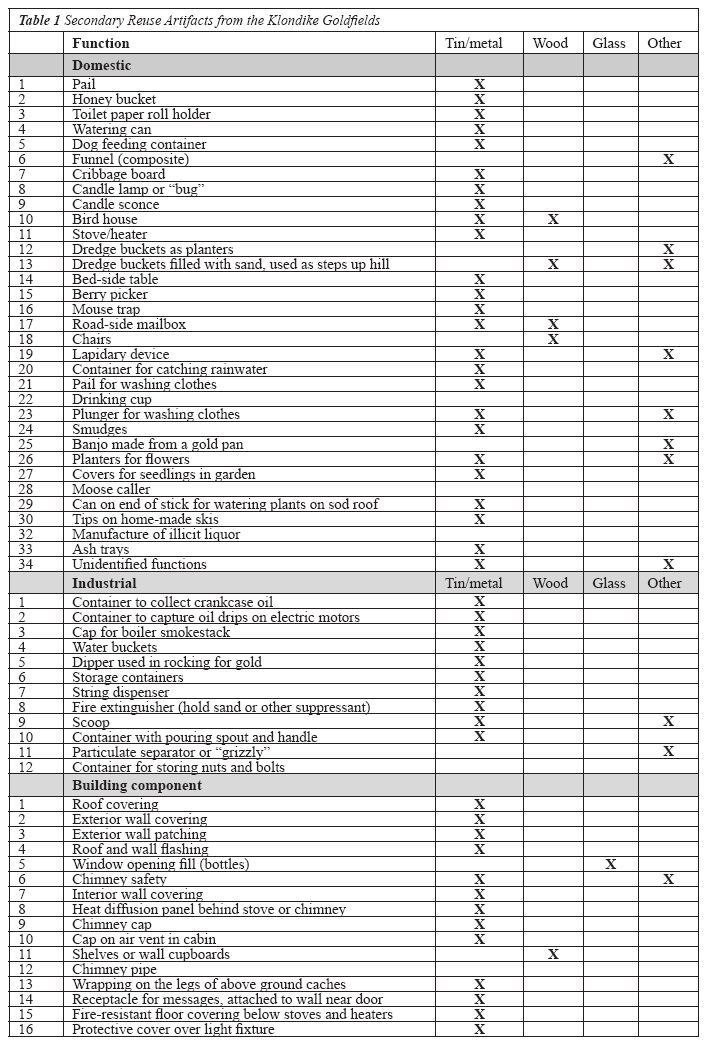
Display large image of Table 1
34 So too, have the current circumstances surrounding secondary reuse changed in the goldfields. While tin containers continue to be the main form of containment for food and other products, they are now whisked away for recycling. Wooden product containers are not common as they once were, and it is certainly easier to travel to Dawson for provisioning and resupply. Plastic has gained prominence as a packaging material; its re-workability is more limited than was that of the tin can. Examples of its reuse are more frequently those of whimsy and decoration. Further examination of these changes and the differences of application of reuse would be worthy of further discussion beyond the scope of the current essay. What is important to remember is that the context within which this phenomenon is evident reveals much about the life and times of the creators. Study and analysis of secondary reuse within and between different regions of the world will reveal interesting or important insights into the cultures being studied.
References
Adney, Tappen. 1994. The Klondike Stamped. Vancouver: UBC Press.
Berton, Laura. 1972. I Married the Klondike. Toronto: McClelland and Stewart.
Berton, Pierre. 1973. Drifting Home. Toronto: McClelland and Stewart.
———. 1987. Starting Out. Toronto: McClelland and Stewart.
Gates, Michael. 1994. Gold at Fortymile Creek. Vancouver: UBC Press.
Hall, Stephen S. 1985. Escape to Alcatraz. National Geographic Traveler 2 (Summer).
Hunter, Celia.1984. The Ubiquitous Blazo Box. Alaska Magazine 50 (3).
Martinsen, Ella Lung. 1969. Trail to the North Star Gold. Portland: Metropolitan Press.
Munch-Petersen, Nils Finn. 1980. Genbrug af blikdåser. København: Nationalmuseet.
Nicolaisen, Wilhelm H.F. 1979. “Distorted Function” in Material Aspects of Culture. Folklore Forum12 (1-3): 223-35.
Procter, Hazel T. 1975. Tenderfoot to Sourdough: The True Adventures of Amos Entheus Ball in the Klondike Gold Rush as Told in His Own Words. New Holland, Pennsylvania: Edward Procter Publisher.
Schiffer, Michael B., Theodore E. Downing and Michael McCarthy. 1981. Waste Not, Want Not: An Ethnoarchaeological Study of Reuse in Tucson, Arizona. In Modern Material Culture: The Archaeology of Us, eds. Richard A. Gould and Michael B. Schiffer, 67-86. New York: Academic Press.
Specht, Robert. 1976. Tisha: The Story of a Young Teacher in the Alaska Wilderness. Toronto: Bantam Books.
Stanley, William. 1898. A Mile of Gold. Chicago: Laird and Lee.
Notes
